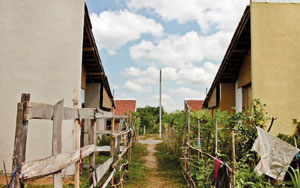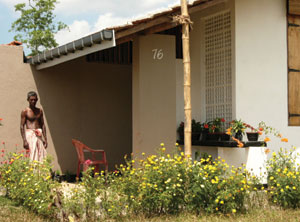The tsunami that hit Sri Lanka in December 2004 was the greatest natural disaster faced by the country. It was a catastrophe that left a high death toll in the coastal regions of the island. Local communities, with their loved ones, their hopes and dreams swept away by the angry sea, were left with shattered lives and broken homes.
But with this terrifying ordeal rose a sense of help and support. Many rushed to the aid of the tsunami victims. Numerous individuals and organizations launched projects to assist them. Among them health, food and water and shelter became a primary concern.
 |
| A sense of community: Separate but close enough for interaction; (bottom) : A little patch : Enough space for green fingers; |
 |
Amidst this rehabilitation process, Lion Breweries Ceylon Ltd. contacted Sheran Henry Associates, an architectural firm they have had a trusted relationship with over a long period of time. The proposal was to design and construct a low cost housing scheme appropriate for low-income families as a free, charity project. The firm readily agreed.
The housing project taken on by Sheran Henry was part of a larger housing scheme for the tsunami victims. The Tsunami Housing Project in Payagalawatta is located in Kalutara, some five km off the Colombo-Galle Road. The scheme, completed within two to three months consisted of 18 housing units on 10 perches of land. Each unit was 700 sq. ft in size comprising a large verandah, two bedrooms, kitchen and outdoor toilet.
The settlement was to house a low income, unsophisticated group of people who led largely community-based lifestyles. Architect Sheran Henry discussing the idea behind his design said, “When we design for our clients, we want the design to reflect them. It could be a Rs.40 million, 50 million house they want or a three or four lakh house, we still make it about them. We design it specifically for the client. In this case the low income society is not as complex as the traditional middle income or high income clientele. They are very basic and simple.
They live for the day, for each moment. It was that we focused on when designing. We wanted to preserve that lifestyle and not alienate them from it.”
The design is simple and uncluttered. The linear allocation of space and the single pitch roof are examples of minimalism in structure. The location surrounded by picturesque paddy fields and shady rubber estates heightens the sense of calm and serenity. The houses are along the edge of the land openings, their façade to the street while at the same instance creating maximum garden space. This serves two purposes, one of a communal nature and the other a functional one.
“They can’t afford the luxuries of a television or computer. They don’t have DVD players or sometimes even a radio. Their entertainment is provided by being with each other,” says Sheran. “And it is together that they are strong. The main focus therefore is the street. That is where you will stop and talk to people. It is an important aspect in the lives of these people. That is why the façade and verandah look directly over the street.” The lack of restricting boundary walls adds to the flexibility of interaction in the community.
The requirements of the women folk were also not overlooked by the design team. The kitchen opens out to a wide garden. Today it is full of vegetation and trees. Because they spend most of the day in the kitchen, the women overlook colourful flowers and greenery and pick some of their very own fruits and vegetables from the garden itself. The outdoors also works as a play area for the children. And from the kitchen the mothers can keep a watchful eye on them while preparing the meals and going about their work.
The partitioning within the house is limited. The walls do not run up the entire length up to the roof. This too is done to avoid a sense of restriction and to provide effective ventilation. The grills on the façade are also designed for cross ventilation and.
“We didn’t want them to use fans or spend a lot on electricity for lighting,” explains Sheran. Design implementations are created for maximum air flow within the structure. The aim is to keep a cool breeze flowing constantly within the house. The interior is exposed to many open spaces while the walls are painted white. This is again to minimize the use of electrically generated lighting. The soft natural light hitting the white walls, reflects off the surface, illuminating the interior of the house and also making the space feel more open and less restrictive.
The use of material is simple and basic. The brick paved verandah with the concrete built in seat, the coconut timber rafters covered in Calicut tile are a few examples of the unsophisticated use of material. They are left in their truest form and colour. The palette used for the house is very subdued and natural - an exterior of earthy mustards, soft greys and deep greens complement the white of the interior.
Apart from being a gesture of care and humanity, the most distinctive feature of the Tsunami Housing Project in Payagalawatta is the amalgamation of design and functionality. Every aspect of design has a function attached to it, giving it both aesthetic value and practical purpose. |



